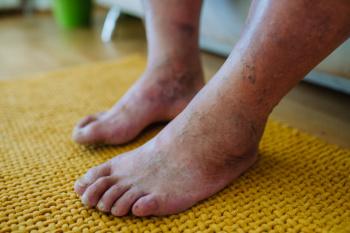March 2024
Plantar Warts Can Be Treated!
Big Toe Joint Pain May Signal Turf Toe
 Turf toe is an injury common among athletes, particularly those who play on hard surfaces like artificial turf. It occurs when the big toe bends too far upwards, stretching or tearing the soft tissue underneath the toe joint. This type of injury is most often seen in sports that involve rapid starts, stops, and turns, leading to a sudden forceful impact on the toe. Symptoms of turf toe include pain at the base or joint of the big toe, swelling, and limited joint movement, making it difficult to walk or run. Some people also experience a popping sensation at the time of the injury. Symptoms may be more severe if there is extensive damage to the soft tissue. Proper diagnosis and treatment are important to manage pain, reduce inflammation, and ensure a full recovery. If you have big toe joint pain, it is suggested that you make an appointment with a podiatrist, or foot doctor, for diagnosis. Turf toe is not the only possible cause of big toe joint pain, and each condition has specialized treatment that podiatrists may recommend.
Turf toe is an injury common among athletes, particularly those who play on hard surfaces like artificial turf. It occurs when the big toe bends too far upwards, stretching or tearing the soft tissue underneath the toe joint. This type of injury is most often seen in sports that involve rapid starts, stops, and turns, leading to a sudden forceful impact on the toe. Symptoms of turf toe include pain at the base or joint of the big toe, swelling, and limited joint movement, making it difficult to walk or run. Some people also experience a popping sensation at the time of the injury. Symptoms may be more severe if there is extensive damage to the soft tissue. Proper diagnosis and treatment are important to manage pain, reduce inflammation, and ensure a full recovery. If you have big toe joint pain, it is suggested that you make an appointment with a podiatrist, or foot doctor, for diagnosis. Turf toe is not the only possible cause of big toe joint pain, and each condition has specialized treatment that podiatrists may recommend.
Toe pain can disrupt your daily activities. If you have any concerns, contact Dr. Anna Petrov of Family Foot & Ankle Care. Our doctor can provide the care you need to keep you pain-free and on your feet.
What Causes Toe Pain?
Most severe toe pain is caused due to a sports injury, trauma from dropping something heavy on the toe, or bumping into something rigid. Other problems can develop over time for various reasons.
Toe pain can be caused by one or more ailments. The most common include:
- Trauma
- Sports injury
- Wearing shoes that are too tight
- Arthritis
- Gout
- Corns and calluses
- Hammertoe
- Bunions
- Blisters
- Ingrown toenails
- Sprains
- Fractures (broken bones)
- Dislocations
When to See a Podiatrist
- Severe pain
- Persistent pain that lasts more than a week
- Signs of infection
- Continued swelling
- Pain that prevents walking
Diagnosis
In many cases the cause of toe pain is obvious, but in others, a podiatrist may want to use more advanced methods to determine the problem. These can range from simple visual inspections and sensation tests to X-rays and MRI scans. Prior medical history, family medical history, and any recent physical traumatic events will all be taken into consideration for a proper diagnosis.
Treatment
Treatments for toe pain and injuries vary and may include shoe inserts, padding, taping, medicines, injections, and in some cases, surgery. If you believe that you have broken a toe, please see a podiatrist as soon as possible.
If you have any questions please feel free to contact one of our offices located in Wheeling and Chicago, IL . We offer the newest diagnostic tools and technology to treat your foot and ankle needs.
Treatment for a Dislocated Ankle

Experiencing a dislocated ankle can be a traumatic event, often leading to significant damage and requiring specialized treatment. A podiatrist, who is an expert in foot and ankle conditions, plays an essential role in managing such injuries. Treatment, which typically involves realigning the ankle joint, may also require the application of a splint or cast for stabilization. In severe cases involving fractures, surgery may be necessary to ensure proper healing. The recovery process varies in duration, emphasizing the importance of regular follow-up appointments with a podiatrist to monitor progress and address any emerging issues. Podiatrists possess the expertise to provide targeted care, facilitating optimal recovery, and minimizing the risk of complications. If you have dislocated an ankle, it is suggested that you schedule an immediate appointment with a podiatrist who can perform a thorough exam, and offer the correct treatment and follow-up care you need.
Ankle pain can be caused by a number of problems and may be potentially serious. If you have ankle pain, consult with Dr. Anna Petrov from Family Foot & Ankle Care. Our doctor will assess your condition and provide you with quality foot and ankle treatment.
Ankle pain is any condition that causes pain in the ankle. Due to the fact that the ankle consists of tendons, muscles, bones, and ligaments, ankle pain can come from a number of different conditions.
Causes
The most common causes of ankle pain include:
- Types of arthritis (rheumatoid, osteoarthritis, and gout)
- Ankle sprains
- Broken ankles
- Achilles tendonitis
- Achilles tendon rupture
- Stress fractures
- Bursitis
- Tarsal tunnel syndrome
- Plantar fasciitis
Symptoms
Symptoms of ankle injury vary based upon the condition. Pain may include general pain and discomfort, swelling, aching, redness, bruising, burning or stabbing sensations, and/or loss of sensation.
Diagnosis
Due to the wide variety of potential causes of ankle pain, podiatrists will utilize a number of different methods to properly diagnose ankle pain. This can include asking for personal and family medical histories and of any recent injuries. Further diagnosis may include sensation tests, a physical examination, and potentially x-rays or other imaging tests.
Treatment
Just as the range of causes varies widely, so do treatments. Some more common treatments are rest, ice packs, keeping pressure off the foot, orthotics and braces, medication for inflammation and pain, and surgery.
If you have any questions, please feel free to contact one of our offices located in Wheeling and Chicago, IL . We offer the newest diagnostic and treatment technologies for all your foot care needs.
Surgical Fungal Toenail Removal

Dealing with stubborn fungal toenails? Surgical toenail removal might be the solution. This procedure is typically done in a podiatrist's office under local anesthesia to ensure comfort. The toenail removal process involves loosening the skin around the toenail and removing either the entire nail or just the affected portion, depending on the severity of the infection. To prevent regrowth and future fungal toenail infections, the nail matrix can be destroyed using a chemical solution after removal. Post-surgery, proper wound care includes gentle washing with clean water and avoiding harsh substances like hydrogen peroxide or alcohol. Healing usually takes a few weeks, with toenails growing back within a year to 18 months. Surgical toenail removal is reserved for cases where a significant portion of the nail is diseased or causing severe pain. If fungal toenails are impacting your life, it is suggested that you make an appointment with a podiatrist to explore treatment options, including surgical intervention if necessary.
If left untreated, toenail fungus may spread to other toenails, skin, or even fingernails. If you suspect you have toenail fungus it is important to seek treatment right away. For more information about treatment, contact Dr. Anna Petrov of Family Foot & Ankle Care. Our doctor can provide the care you need to keep you pain-free and on your feet.
Symptoms
- Warped or oddly shaped nails
- Yellowish nails
- Loose/separated nail
- Buildup of bits and pieces of nail fragments under the nail
- Brittle, broken, thickened nail
Treatment
If self-care strategies and over-the-counter medications does not help your fungus, your podiatrist may give you a prescription drug instead. Even if you find relief from your toenail fungus symptoms, you may experience a repeat infection in the future.
Prevention
In order to prevent getting toenail fungus in the future, you should always make sure to wash your feet with soap and water. After washing, it is important to dry your feet thoroughly especially in between the toes. When trimming your toenails, be sure to trim straight across instead of in a rounded shape. It is crucial not to cover up discolored nails with nail polish because that will prevent your nail from being able to “breathe”.
In some cases, surgical procedure may be needed to remove the toenail fungus. Consult with your podiatrist about the best treatment options for your case of toenail fungus.
If you have any questions, please feel free to contact one of our offices located in Wheeling and Chicago, IL . We offer the newest diagnostic and treatment technologies for all your foot care needs.
Support in Diabetic Foot Care

Diabetes poses risks of foot ulcers and other foot problems, but proactive care can lessen these dangers. Regular checkups with a podiatrist are important for diabetic individuals. Besides professional care, daily self-checks are imperative. Interestingly, involving spouses in foot care can enhance vigilance. Research comparing diabetic individuals receiving guidance alone to those and their spouses found higher rates of foot checking in the coupled group. While both groups had similar levels of foot protection behavior, spousal support boosted overall foot care in the dyad group. This underscores the importance of involving loved ones and caregivers in diabetic foot care routines. If you have diabetes, it is suggested that you seek support and schedule regular appointments with a podiatrist for checkups. This will help individuals with diabetes to better prevent complications and maintain foot health.
Diabetic foot care is important in preventing foot ailments such as ulcers. If you are suffering from diabetes or have any other concerns about your feet, contact Dr. Anna Petrov from Family Foot & Ankle Care. Our doctor can provide the care you need to keep you pain-free and on your feet.
Diabetic Foot Care
Diabetes affects millions of people every year. The condition can damage blood vessels in many parts of the body, especially the feet. Because of this, taking care of your feet is essential if you have diabetes, and having a podiatrist help monitor your foot health is highly recommended.
The Importance of Caring for Your Feet
- Routinely inspect your feet for bruises or sores.
- Wear socks that fit your feet comfortably.
- Wear comfortable shoes that provide adequate support.
Patients with diabetes should have their doctor monitor their blood levels, as blood sugar levels play such a huge role in diabetic care. Monitoring these levels on a regular basis is highly advised.
It is always best to inform your healthcare professional of any concerns you may have regarding your feet, especially for diabetic patients. Early treatment and routine foot examinations are keys to maintaining proper health, especially because severe complications can arise if proper treatment is not applied.
If you have any questions please feel free to contact one of our offices located in Wheeling and Chicago, IL . We offer the newest diagnostic and treatment technologies for all your foot and ankle needs.









